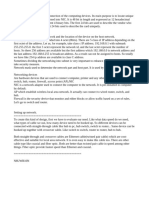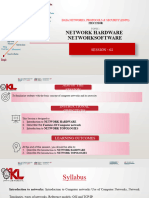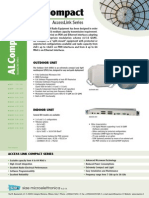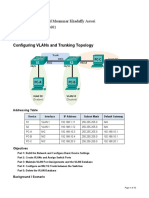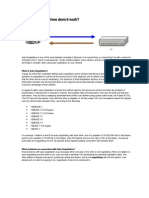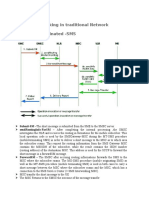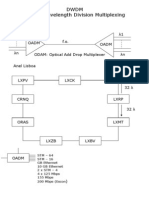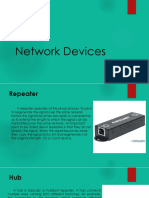Module 10
Planning and Cabling
Networks
�Objectives
LAN Marking the Physical Connection
Device Interconnections
Developing an Addressing Scheme
Calculating the Subnets
Device Interconnections
�LAN Marking the Physical Connection
�Choosing Appropriate LAN Device
�Choosing Appropriate LAN Device
�Device Selection Factors
Factors to Consider in Choosing a Device
�Device Selection Factors
Factors Determining LAN Switch Selection
�Device Selection Factors
Factors Determining LAN Switch Selection Port Speeds, Types and Expandability
�Device Selection Factors
Cisco Routers
Each series of Cisco router provides
expandability, support for multiple media types,
and various system features and services.
�Device Interconnections
10
�LAN and WAN Getting Connected
LAN Cabling Areas
11
�LAN and WAN Getting Connected
Type of Device Interconnection
12
�Marking LAN Connections
RJ45 T568A & T568B Connections
13
�Marking LAN Connections
Straight-Through Cable have the same
termination at each end T568A or T568B
Two types of UTP interfaces: MDI and
MDIX.
The MDI (media-dependent interface):
Uses the normal Ethernet pinout. Pins 1
and 2 are used for transmitting and pins
3 and 6 are used for receiving.
Devices such as computers, servers, or
routers will have MDI connections.
The MDIX (media-dependent interface,
crossover):
The devices that provide LAN
connectivity usually hubs or switches
Swap the transmit pairs internally. This
swapping allows the end devices to be
connected to the hub or switch using a
straightthrough cable.
Straight-Through Cable have the same
termination at each end T568A or T568B
14
�Marking LAN Connections
Crossover Cables have a T568A termination at one end
and a T568B termination at the other end
15
�Marking LAN Connections
Identify the correct UTP cable type and likely category to
connect different intermediate and end device in a LAN
Many devices allow the
UTP Ethernet port to be
set to MDI or MDIX.
This can be done in one
of three ways:
Ports may have a
mechanism that
electrically swaps
the transmit and
receive pairs
As part of the
configuration
Many newer devices
have an automatic
crossover feature
16
�Marking WAN Connections
Type of WAN Connections
17
�Marking WAN Connections
Type of WAN Connections - Serial
18
�Marking WAN Connections
Type of WAN Connections - DSL
19
�Marking WAN Connections
Data Communications Equipment (DCE) - A device that supplies the
clocking services to another device. Typically, this device is at the WAN
access provider end of the link.
Data Circuit-Terminal Equipment (DTE) - A device that receives clocking
services from another device and adjusts accordingly. Typically, this device is
at the WAN customer or user end of the link.
20
�Marking WAN Connections
Serial WAN Connections in the Lab
21
�Developing an Addressing Scheme
22
�How Many Hosts in the Network ?
Determining the Number of Hosts in the Network
Include these devices in the count:
23
�Designing the Address
Standard for our Internetwork
General users = .64 - .127
Special users = .8 - .15 (Network Administrator)
Network resources = .224 - .239
Router LAN interfaces = .250 - .254
Management access = .192 - .207
Router WAN links = .1 - .2
24
�Calculating the Subnets
25
�Introduction to Subnetting
Subnetting a network means
to use the subnet mask to divide
the network and break a large
network up into smaller, more
efficient and manageable segments,
or subnets.
Subnet addresses include the network portion, plus a subnet
field and a host field.
To create a subnet address, a network administrator borrows
bits from the host field and designates them as the subnet field
26
�Classes of Network IP addresses
27
�Subdividing an /24 network address
Number of subnets = 2n = 23 =8
with n is number of bits that are borrowed.
Number of hosts per subnet = 2m 2 = 28-3 - 2 = 30
with m is number of remaining bits.
28
�Writing down the subnets
Determine the network address of subnets from 3
borrowed bits from the host portion (the last byte):
1st subnet: .00000000 192.168.10.0
2nd subnet: .00100000 192.168.10.32
3rd subnet: .01000000 192.168.10.64
4th subnet: .01100000 192.168.10.96
5th subnet: .10000000 192.168.10.128
6th subnet: .10100000 192.168.10.160
7th subnet: .11000000 192.168.10.192
8th subnet: .11100000 192.168.10.224
29
�Writing down the subnets
Determine the broadcast address of subnets:
1st subnet: .00011111 192.168.10.31
2nd subnet: .00111111 192.168.10.63
3rd subnet: .01011111 192.168.10.95
4th subnet: .01111111 192.168.10.127
5th subnet: .10011111 192.168.10.159
6th subnet: .10111111 192.168.10.191
7th subnet: .11011111 192.168.10.223
8th subnet: .11111111 192.168.10.255
30
�How Many Network ?
31
�Calculating Addresses
Network Topology
Given IP Address:
172.16.0.0/21
32
�Calculating Addresses
Calculating Address Ranges for Subnets
33
�Good luck with this module!
34







